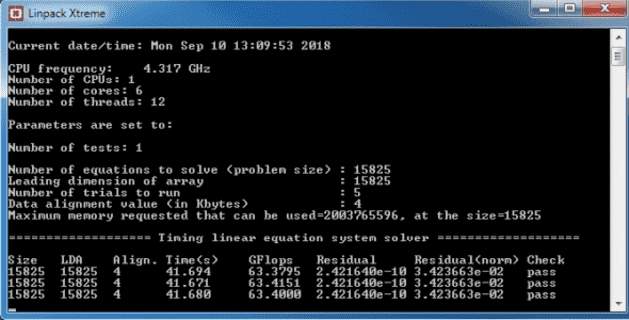
LINPACK was designed to help users estimate the time required by their systems to solve a problem using the LINPACK package, by extrapolating the performance results obtained by 23 different computers solving a matrix problem of size 100. Our poster presentation will follow a standard poster format, and will present the data of our statistical analysis in detail. The LINPACK benchmark report appeared first in 1979 as an appendix to the LINPACK users manual. LINPACK benchmarks The LINPACK library has been used extensively in the computing industry as a performance benchmark, and results have been tabulated for a very large number of computers in a report that is updated approximately twice a year. Linpack solves a dense (real8) system of linear equations (Axb), measures the amount of time it takes to factor and solve the system, converts that time into a performance rate, and tests the results for accuracy. Hence three (or four with EP) benchmarks are sufficient to characterize the overall NPB performance. Linpack Xtreme is a console front-end with the latest build of Linpack (Intel Math Kernel Library Benchmarks 2018.3.011). 3) The remaining NPB can grouped into three groups as follows: (CG and IS), (LU and SP), and (MG, FT, and BT). In addition to the performance results of LINPACK and the eight NAS parallel benchmarks, we have also included peak performance of the machine, and the LINPACK n and n(sub 1/2) values. 2) LINPACK and EP have each a unique signature. In this study we have used the reported benchmark results and performed a number of statistical experiments using factor, cluster, and regression analyses.

Below is an overview of the generalized performance for components where there is sufficient statistically significant data based upon user-uploaded results. Some of the results and observations can be summarized as follows: 1) All benchmarks are strongly correlated with peak performance. metrics for this test profile configuration based on 61 public results since 6 March 2021 with the latest data as of 12 January 2022. These are the benchmarks whose results are most often cited in manufacturers’ publications and in the trade press. All subsequent results were obtained with the binary of the C version of the benchmark ( linpack.tos ) in this repository, with double precision and using the default array size when prompted (200, which results in a n100x100 matrix to be solved). In addition to the performance results of LINPACK and the eight NAS parallel benchmarks, we have also included peak performance of the machine, and the LINPACK n and n(sub 1/2) values. common stone age benchmarks (CPU/ memorykompiler benchmarks only) - in particular the Whetstone, Dhrystone, and Linpack benchmarks. Results Note that to some degree the results depend on the compiler that is used and on its options. In this study we have used the reported benchmark results and performed a number of statistical experiments using factor, cluster, and regression analyses.

Statistical Analysis of NAS Parallel Benchmarks and LINPACK Results In the last three years extensive performance data have been reported for parallel machines both based on the NAS Parallel Benchmarks, and on LINPACK.


 0 kommentar(er)
0 kommentar(er)
